There is something almost magical about the moment a loaf of vörtbröd comes out of the oven. The warm steam that escapes carries...


🐣 Easter the Scandinavian Way!
Easter, or Påsk in Swedish, is a colorful and cozy spring celebration across Scandinavia. It blends Christian customs with old folklore and springtime joy. Unlike the bunny-led traditions elsewhere, in Sweden you’ll find kids dressing up as påskkärringar (Easter witches), going door-to-door with drawings in exchange for candy. Homes are decorated with påskris – bare birch twigs adorned with feathers and ornaments – symbolizing life returning after winter.
In true Nordic style, Easter is also about slowing down, gathering with family, and enjoying long meals filled with traditional food, drinks, and sweets.
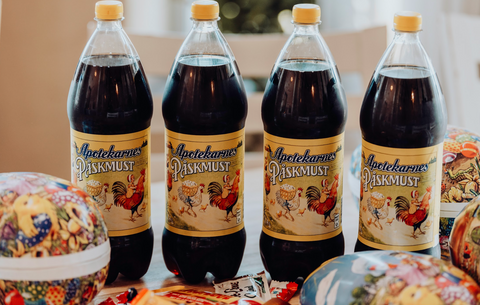
🍻 Easter Drinks in Scandinavia: From Påskmust to Snaps 🥤
In Scandinavia, no celebration is complete without something to raise your glass with – and Easter is no exception. Just like the food, drinks during Påsk reflect a blend of long-standing traditions, seasonal rituals, and that signature Swedish knack for balancing fun with finesse.
At the heart of the Swedish Easter beverage lineup is påskmust – a sweet, dark, spiced malt soda that holds a nostalgic place in every Swede’s heart. Its unique flavor comes from a secret blend of spices and hops, and although it's technically non-alcoholic, it’s treated with the same reverence as a fine wine during the holidays. Children and adults alike enjoy it chilled, poured into tall glasses alongside lunch or dinner.
Many people notice it tastes similar to julmust, the Christmas version, and that’s because they’re nearly identical – but don’t tell that to a Swede! Påskmust comes with its own yellow Easter labels, and for many, it marks the official arrival of spring.
🥂 Fun fact: During Easter, sales of påskmust often surpass those of Coca-Cola in Sweden!
For adults, Easter wouldn't be complete without a little snaps – a shot of strong Scandinavian spirit, usually aquavit, that’s flavored with herbs like dill, caraway, fennel, or anise. It's traditionally served ice-cold in tiny glasses, sipped slowly (despite its strength), and always accompanied by a good cheer or a snapsvisa – a short, often humorous drinking song sung at the table.
Aquavit has a bold, botanical flavor that pairs wonderfully with typical Easter fare – especially salty or pickled dishes like herring, gravlax, or egg-based appetizers.
🎶 Swedish Easter tables often break into song between sips of snaps – the most famous being “Helan går,” which signals that the first drink of the meal is about to be downed in one go!
Lighter beers also make a frequent appearance at the Easter table, especially lager-style beers that are crisp, refreshing, and perfect for a daytime meal. Many Swedish craft breweries release seasonal Easter brews (påsköl) with slightly malty, mellow notes that pair well with rich dishes like Janssons frestelse or smoked meats.
If the weather permits, it’s common for Swedes to enjoy these beers outdoors – soaking up the elusive spring sun on a balcony, porch, or picnic bench.
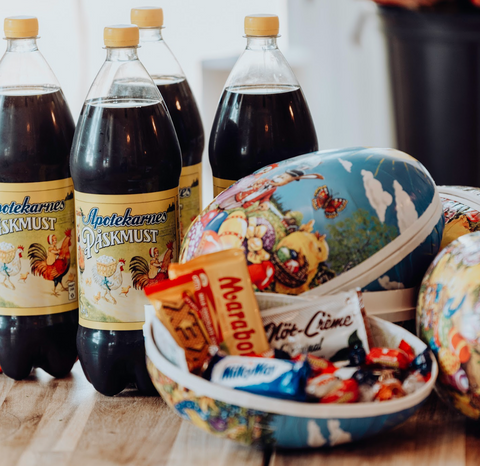
🍬Easter Desserts & Sweets🍬
If there's one thing Swedes truly go all-in on during Easter, it's candy – or påskgodis. While the holiday carries religious and folkloric traditions, for many children (and let’s be honest, plenty of adults), the real highlight is the sugar-fueled joy of Easter weekend.
Every Swedish household, from the countryside to city apartments, embraces the sweet side of påsk. Colorful confections take center stage, and it's all about indulging in playful, nostalgic treats that capture the spirit of spring and togetherness.
One of the most iconic Swedish Easter traditions is the påskägg – a large, hollow cardboard Easter egg, beautifully decorated with bright colors and springtime scenes. These aren’t your average chocolate eggs. Instead, they're filled to the brim with a mix of sweets, chocolates, and sometimes small gifts or coins.
Parents hide them around the house or garden for the children to find, or simply surprise them at the breakfast table on Easter Sunday. It's also common to exchange them with friends or loved ones – a cheerful, candy-filled gesture of affection.
✨ A typical påskägg might include: sour gummies, chocolate eggs, licorice, marshmallow chicks, and colorful foil-wrapped sweets – a personalized candy treasure chest.
The range of Easter sweets in Sweden is both whimsical and wonderfully varied. Here are some of the most beloved classics:
Soft, almondy marzipan shaped into little yellow chicks, eggs, and bunnies. Often handmade or found in specialty shops, these treats are a nostalgic nod to old-school Easter charm.
From tiny chocolate dragées to large filled eggs wrapped in foil, Swedish Easter chocolate comes in all forms. Some are solid, others filled with nougat, praline, or marshmallow. Brands like Marabou, Anthon Berg, and Fazer create special seasonal assortments.
Tangy, chewy, and shaped like cute little bunnies, these are an absolute hit with kids. The sour coating gives a fun twist that balances all the sweetness.
No Swedish candy tradition is complete without lakrits (licorice). Easter brings playful variations like black or speckled “eggs” made from sweet or salty licorice – often with surprise fillings.
Although traditionally eaten before Lent, semlor (cardamom buns filled with almond paste and whipped cream) sometimes stick around until Easter. Especially in southern Sweden, a semla might sneak onto the dessert table – because why not?
Swedish Sticky Easter Cake 🍰
Kladdkakan, the endlessly popular Swedish sticky cake that is the kids’ favourite is super easy to make. One of the reasons why kladdkakan has become so popular and won the hearts of the Swedish people is probably because there are so few ingredients involved and that the procedure is so simple. Almost anyone can put together a good kladdkaka. Now why not make an Easter version of the kladdkaka? Let’s introduce “påskkladdkakan”, a version of the kladdkaka but with white chocolate, lemon and the addition of Easter candy on top. Delicious! Let’s make it!
All you need is: 100 g butter, 100 g white chocolate, grated rind of 1 lemon, 2 dl caster sugar, 1 tsp vanilla sugar, 1 tsp salt, 2 eggs, 2 dl wheat flour, 50 g dark baking chocolate (55%), candy eggs and/or Easter candy.
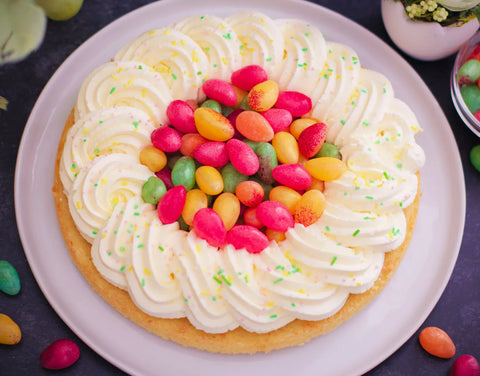
1. Set the oven to 175°C.
2. Melt the butter in a pan, remove from the plate. Break the chocolate into pieces and put it in the butter and let it melt while stirring. Grate the outermost peel of the lemon.
3. Stir lemon zest, sugar, vanilla sugar, salt and one egg at a time into the butter and chocolate mixture. Mix the flour into the batter and pour into the mold.
4. Bake the cake in the middle of the oven for about 20 minutes.
5. Let the cake cool.
6. Garnish: Chop the chocolate into smaller pieces and place in a piping bag and seal it. Melt the chocolate in the microwave or in a water bath.
7. Place the cake on a serving plate. Cut a small hole in the piping bag and drizzle over the chocolate.Alternatively you can cover the cake with whipped cream
8. Garnish with your favourite Easter candy.
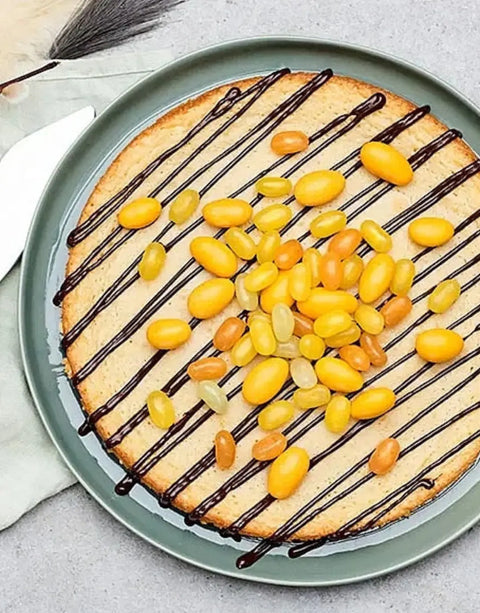
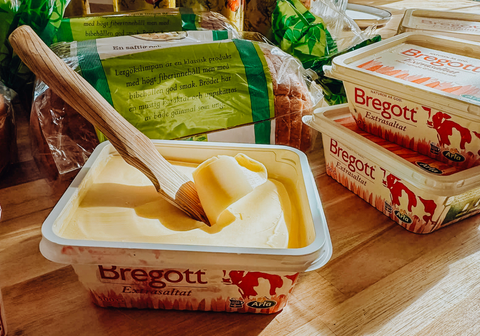
🍽️ Easter Foods in Sweden
Swedes take great pride in their seasonal feasts, and Easter – or Påsk – is no exception. The Easter spread is deeply rooted in tradition and offers a joyful blend of springtime freshness and nostalgic flavors. In many ways, it mirrors a lighter version of the beloved julbord (Christmas buffet), but with more focus on eggs, fish, and seasonal brightness.
At the heart of the Easter table lies a smörgåsbord-style buffet, where every dish has its own place and purpose. Meals are often served buffet-style so that family and guests can graze slowly, enjoying conversation and music over several hours.
Here are some of the beloved highlights:
Pickled herring is an absolute must at any Swedish holiday table. It comes in a variety of flavors – classic onion, mustard, dill, even curry or garlic – served cold in glass jars. Each person has their favorite, and it’s often enjoyed with new potatoes, chives, and a dollop of sour cream. This dish pairs perfectly with crispbread and a shot of aquavit.
Gravlax is salmon cured with a mixture of salt, sugar, and fresh dill, usually prepared several days ahead. Thinly sliced and served cold, it’s often accompanied by a tangy mustard-dill sauce called hovmästarsås. It’s elegant, light, and full of flavor – a true Nordic delicacy that brings spring to the plate.
Eggs are a major Easter symbol, and Swedes honor them not only in chocolate form but also in delicious savory dishes. Hard-boiled eggs are cut in halves or quarters and topped with things like roe, mayonnaise, pickled red onions, or fresh dill. They’re not just beautiful on the table – they’re a fresh and protein-rich contrast to heavier items.
This comforting potato casserole is a creamy, savory classic. Made from thinly sliced potatoes baked with onions, cream, and Swedish-style anchovies (ansjovis – which are actually spiced sprats), it’s rich and hearty with just the right touch of sweetness and saltiness. Despite being a Christmas staple, many families insist it belongs on the Easter table too.
No Swedish feast is complete without köttbullar (meatballs) and prinskorv (short, lightly smoked sausages). These warm, meaty bites are especially loved by kids and round out the otherwise fish-heavy buffet. They're often served with sweet mustard or lingonberry jam.
For texture and contrast, crispbread (knäckebröd) plays an important role. It’s topped with everything from creamy spreads to thin slices of Västerbotten cheese – a sharp, nutty cheese from northern Sweden, often called the “king of cheeses.” Add a slice of boiled egg and a sprig of dill, and you have a perfect bite.
🪺 Easter Decorations the Scandinavian Way
Swedish Easter is a feast for the eyes as much as the table. The season marks the joyful arrival of spring after a long, dark winter — and with it comes a burst of color, light, and natural beauty. Decorations play a big role in creating that special påskstämning (Easter atmosphere), and in true Scandinavian fashion, the aesthetic is charmingly simple, rustic, and inspired by nature.
Unlike the glitter-heavy approach seen in some countries, Swedish Easter décor is all about light tones, handmade touches, and elements that connect us to the natural world: wood, feathers, fresh flowers, twigs, and soft pastels.
No Swedish Easter home is complete without a påskris – a bouquet of bare birch twigs placed in a vase and decorated with bright feathers. This custom dates back centuries, originally a symbolic Christian tradition representing penance. Today, it’s a cheerful spring decoration found in nearly every Swedish home.
Feathers are traditionally tied to the twigs in bold Easter colors like yellow, pink, purple, and green. Some families also add hanging ornaments like miniature eggs, birds, or little wooden chickens. Kids often make their own decorations at school or during Easter craft sessions.
Tip: If you don’t have access to birch, any springy branches (like willow or cherry) work beautifully too.
Eggs are the ultimate symbol of rebirth, and in Sweden, they’re not just eaten – they’re painted, displayed, and gifted. Hand-decorated eggs, both real and wooden, are a popular craft activity for kids during påsklovet (Easter break). You’ll find everything from intricate folk designs to minimalist pastel-colored eggs tied with ribbon.
At Easter meals, these decorative eggs often feature in table centerpieces or as personalized place settings. Tuck a mini egg or feather into a linen napkin for that perfect Nordic tablescape.
Spring flowers are a key feature of Swedish Easter décor, often placed in simple ceramic or glass vases throughout the home. Some of the most common Easter blooms include:
påskliljor) – the golden flower of Easter in Sweden
– often in mixed pastel bouquets
and crocuses – early spring favorites for a fragrant touch
– a lovely way to bring greenery indoors
Add moss, stones, or small branches for a woodland-inspired look that connects the indoors to the awakening nature outside.
One of Sweden’s most unique traditions is the påskkärring – the Easter witch. On Maundy Thursday (Skärtorsdag), children dress up as little witches with painted freckles, scarves tied around their heads, and long skirts. They go door-to-door handing out drawings and cards in exchange for candy, much like trick-or-treating.
Miniature witch figurines with brooms are often used as part of the Easter decorations – a whimsical, uniquely Swedish nod to folklore and fun.
Swedish Easter décor reflects the broader values of Nordic design – clean lines, soft textures, and a sense of calm. Use a muted color palette of yellows, whites, soft blues, and greens, accented with natural textures like wood, straw, and wool.
Candles, hand-thrown ceramics, and heirloom items are often mixed in to add warmth and soul to the setting.
We take pride in providing an Extraordinary Customer Experience from beginning to end and if something goes wrong with your delivery we refund you right away, no questions asked, life is too short!